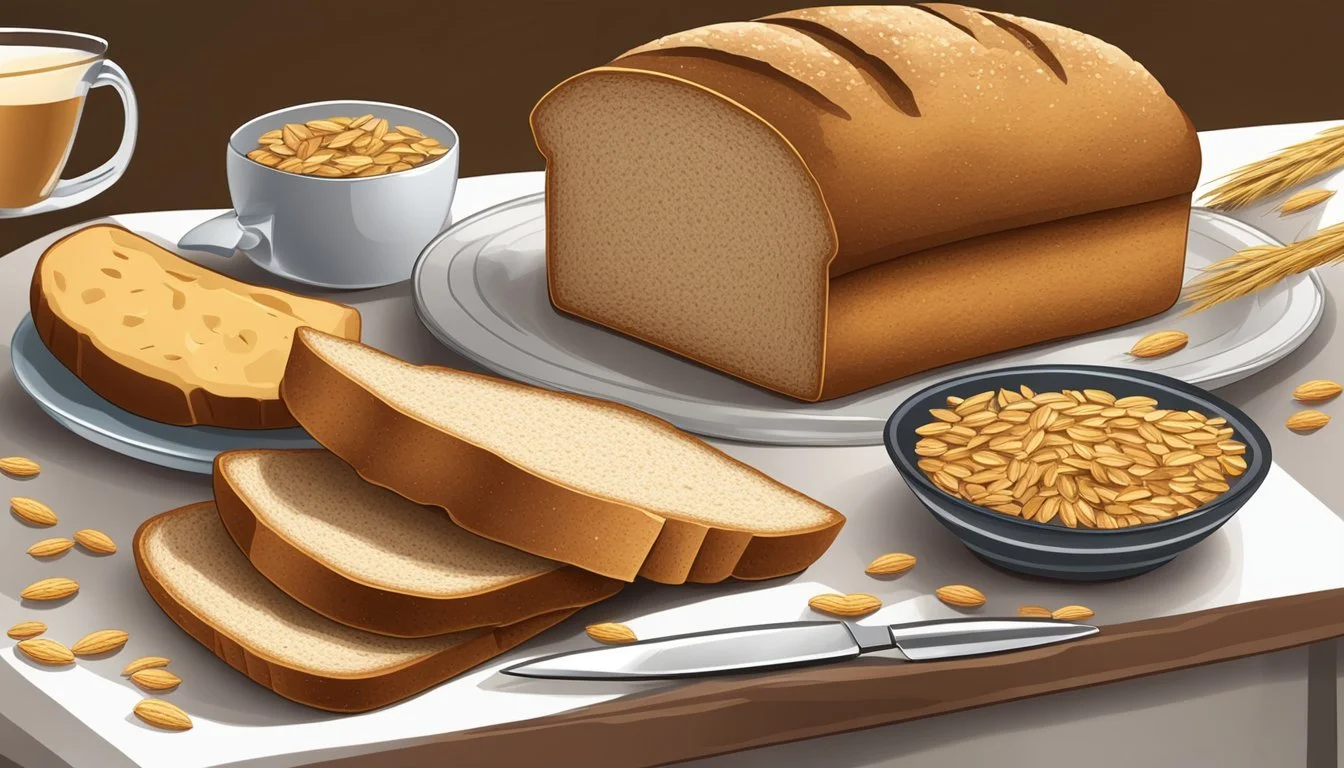How Many Servings of Whole Wheat Bread Per Day Is Excessive?
Understanding Limits for a Balanced Diet
Determining the appropriate daily intake of whole wheat bread hinges on several individual factors, such as age, activity level, and the overall dietary pattern of a person. Whole wheat bread, as part of the grains food group, is a staple in many diets and provides essential nutrients. It's valued for its fiber content, B vitamins, and minerals. A balanced amount can contribute to a healthy diet, aiding in digestion and offering energy for daily activities.
General guidelines suggest that adults might consider consuming between 2 to 4 slices of whole wheat bread per day. This amount equates to approximately 120 to 240 grams, aligning with the body's carbohydrate and fiber needs without excess caloric intake. Children have different nutritional requirements, with younger children (ages 4-8) potentially benefiting from just 1 to 2 slices or 60 to 120 grams, while those aged 9 to 13 may require 2 to 3 slices, equating to 120 to 180 grams daily.
Consuming whole wheat bread in these amounts helps to meet the dietary recommendations for grains, specifically whole grains. It is important for individuals to consider their entire dietary pattern, as whole wheat bread will be part of a wider grain consumption that should ideally comprise half of an individual's total grain intake, according to the latest Dietary Guidelines for Americans. Moderation and balance are key, as an excess of any single type of food, including whole wheat bread, can offset the balance of nutrients the body needs.
Nutritional Profile of Whole Wheat Bread
Whole wheat bread is regarded as a nutritious option due to its composition, which includes a variety of macro and micronutrients. It is a source of fiber and protein and offers more nutrients than many white breads due to the entirety of the grain being used.
Macronutrients and Fiber Content
Whole wheat bread provides a balance of macronutrients. For example, two slices of whole wheat bread contain approximately:
Carbohydrates: 47.29g
Protein: 7.73g
Fat: Around 17% of the total calories
It's particularly noted for its fiber content, which is intrinsic to whole grain. Fiber is beneficial for digestive health, cholesterol levels, and may contribute to a feeling of fullness.
Vitamins and Minerals
This type of bread is a source of several B vitamins, which are essential for energy metabolism and nervous system function. The B vitamins typically found include:
Thiamin
Riboflavin
Niacin
Folate
The bread may also contain levels of minerals like iron and magnesium, which support blood well-being and bone health, respectively.
Comparing Whole Wheat to Other Breads
Compared to white bread and other breads not labeled as 100% whole wheat, whole wheat bread often has a more complete nutrient profile. The bread made from refined grains may lack the full spectrum of vitamins and minerals found in the bran and germ of the whole grain kernel.
When the label specifies 100% whole wheat, it indicates the bread has been made using the entire wheat kernel, thus delivering the full range of nutrition that whole grains are known for.
Health Benefits of Whole Wheat Bread
Whole wheat bread offers a significant contribution to daily nutrient intake and the management of various health aspects. Rich in dietary fiber and essential minerals, it can support bodily functions ranging from digestive health to heart disease prevention.
Digestive Health
Whole wheat bread is high in dietary fiber, which is critical for good digestive health. The bran in whole grains contributes to this fiber content, aiding in smoother digestion and potentially preventing constipation. Some variety of whole wheat breads may contain prebiotic fibers that nourish beneficial gut bacteria.
Blood Sugar Management
Regular consumption of whole grain foods like whole wheat bread can help manage blood sugar levels. The fiber and complex carbohydrates in whole grains result in slower absorption of glucose, which assists in maintaining stable blood sugar levels, a key consideration for those managing diabetes.
Weight Management and Satiety
The fiber in whole wheat bread not only supports the digestive system but also promotes a feeling of fullness or satiety, which can prevent overeating. As part of a balanced diet, whole wheat bread can thus contribute to weight management strategies. It is less energy-dense compared to bread made with refined grains and is more likely to contribute to weight loss when replacing the latter in one's diet.
Heart Health and Disease Prevention
Whole grains, including whole wheat, come with a myriad of heart health benefits. They are known for their role in lowering the risk of heart disease, partially due to the presence of antioxidants and magnesium that support cardiovascular health. Additionally, a diet high in whole grains may be correlated with reduced risk of other chronic diseases such as type 2 diabetes and certain types of cancer.
Recommended Servings and Dietary Guidelines
Determining the ideal number of servings of whole wheat bread per day depends on various dietary guidelines and individual factors such as activity level, metabolism, and overall nutritional needs.
USDA Guidelines and Whole Grain Consumption
The United States Department of Agriculture (USDA) provides recommendations for grain consumption through the Dietary Guidelines for Americans. Adults are generally advised to make at least half of their grains whole grains. For the average adult, this equates to consuming about 3 to 5 servings of whole grains daily. A single serving of whole wheat bread is typically considered to be one ounce or one slice.
Individual Dietary Needs and Variations
Registered dietitians stress that dietary needs can vary greatly from person to person, influenced by factors including age, sex, weight, metabolism, and health condition. It is suggested that individuals should consult a dietitian to tailor their diet, especially when aiming to determine an appropriate number of servings of any food group, including whole grains like whole wheat bread.
Role of Activity Level and Overall Diet
Physical activity levels can greatly affect daily caloric and nutrient requirements. Individuals with higher levels of physical activity may require more servings from the grain group to meet their energy needs. Conversely, less active individuals may need fewer servings. The overall diet should be balanced, incorporating a variety of food groups to achieve a diverse and nutritious diet.
Understanding Food Labels and Bread Choices
When selecting bread, it's essential to understand the nuances of food labeling to ensure you're incorporating the healthiest options into your diet. The terminology used on bread packaging can be complex, so discerning the true meaning of 'whole grain' and 'whole wheat' is crucial, especially if you have specific dietary requirements or health goals.
Decoding 'Whole Grain' and 'Whole Wheat' Labels
When bread is labeled as 100% whole grain, it indicates that all the grain ingredients are complete grains, including the bran, germ, and endosperm. Whole wheat bread refers to bread made specifically from whole wheat grains. To meet nutritional needs effectively, consumers should aim for bread that includes whole grain or whole wheat as the first ingredient.
Look for: "100% whole grain" or "100% whole wheat"
Nutritional benefits: High in fiber, essential nutrients, and can aid in digestion
Choosing the Right Bread for Your Diet
For individuals focused on healthy eating or managing conditions such as celiac disease or gluten sensitivity, it's vital to choose bread that aligns with their dietary requirements.
High Fiber Need: Opt for whole grain breads rich in fiber.
Gluten Sensitivity/Celiac Disease: Choose gluten-free grains like oats or barley.
Wheat Allergies: Avoid any bread containing wheat and look for alternatives.
Refined Grains: Limit breads labeled as "enriched" as they often lack the full spectrum of nutrients found in whole grains.
Spotting Misleading Labels and Marketing
Some bread labels can be misleading, using health-related buzzwords that don't always equate to nutritional benefits. For instance, "multigrain" might not mean whole grains are used. Here's what to watch for to avoid deception:
Misleading Terms: "Multigrain" or "Made with whole grains" may not equate to 100% whole grain content.
Sugars: Check for added sugars that can diminish the healthfulness of bread.
Ingredient List: The closer to the beginning a whole grain is listed, the more of it is in the bread.
Potential Health Considerations and Risks
When considering the consumption of whole wheat bread, it is important to be aware of its impact on blood sugar, the potential risks for those with gluten-related disorders, and the varying intake recommendations for different population groups.
Managing Blood Sugar and Diabetes
Consuming whole wheat bread affects blood sugar levels due to its carbohydrate content. Although whole wheat options have a lower glycemic index compared to white bread, which can help with blood sugar management, it is crucial for individuals with diabetes to monitor their intake. Overconsumption can lead to elevated blood sugar levels, which can exacerbate type 2 diabetes and related complications.
Gluten Sensitivity and Celiac Disease
Whole wheat bread contains gluten, a protein that can cause adverse reactions in people with gluten sensitivity or celiac disease. Ingesting gluten when one has celiac disease can damage the small intestine, leading to nutrients malabsorption and long-term health issues such as chronic diseases. Those with wheat allergies or irritable bowel syndrome (IBS) may also need to avoid whole wheat products, including bread.
Intake Recommendations for Various Populations
A healthy diet that includes whole grains like whole wheat bread is recommended for most Americans, but the amount required can vary. Weight management and overall digestive health benefits are linked with proper fiber intake. However, specific guidelines are tailored to individuals' needs based on factors like age, sex, and level of physical activity. For example, it's generally advised that moderately active men consume more whole grain servings than women, especially in younger age groups.
Incorporating Whole Wheat Bread into a Balanced Diet
Whole wheat bread provides essential nutrients making it a beneficial component of a balanced diet when consumed in moderation and paired with a variety of foods to enhance overall nutrition and appeal.
Creative Culinary Uses of Whole Wheat Bread
Whole wheat flour can transform bread into a versatile element for numerous dishes. Chefs and home cooks alike can:
Craft homemade croutons by cubing whole wheat bread, seasoning with herbs and garlic, and baking until golden.
Use whole wheat bread as a base for healthy and flavorful avocado toast, adding toppings like sliced tomatoes and eggs for a satisfying meal.
Pairing with Proteins, Fruits, and Vegetables
Incorporating whole wheat bread with diverse food groups contributes to a nutrient-dense diet that supports digestive health and satiety. One can:
Complement a slice of whole wheat bread with lean proteins such as grilled chicken or fish to balance the meal.
Create a colorful sandwich full of vegetables and greens for added vitamins and minerals.
Prepare open-faced sandwiches topped with fruits like pear or apple slices combined with a sprinkle of cinnamon for added flavor.
Considerations for a Healthy and Flavorful Diet
When integrating whole wheat bread into one's diet, there are nutritional considerations they should be mindful of:
Pay attention to portion sizes, as whole wheat bread contains calories that must fit within a daily caloric intake conducive to maintaining or achieving a healthy weight.
Consider the nutrient content, recognizing that whole wheat provides fiber which promotes satiety and supports weight loss when included as part of a balanced diet.
Consult a dietitian to personalize bread intake based on individual health goals, physical activity levels, and dietary needs.
Final Considerations on Whole Wheat Bread Consumption
Understanding the optimal intake of whole wheat bread requires a clear look at the consensus from nutritional evidence and expert advice. This section will distill these perspectives while considering the broader implications for health and nutrition.
Summing Up the Evidence on Servings and Health
Nutritional studies consistently reveal that whole wheat bread, as a source of dietary fiber and complex carbohydrates, carries several health benefits. A moderate consumption aligns well with dietary guidelines, suggesting 2-3 servings per day for adults, contributing to weight management and metabolism regulation. It is crucial to consider individual dietary needs, as factors like activity level and metabolism can influence the ideal quantity.
Nutritional Benefits: Each serving of whole wheat bread typically provides protein, zinc, and B vitamins.
Dietary Fiber: The fiber content aids in preventing constipation and may lower the risk of chronic diseases.
Refined Grain Comparison: Whole wheat bread is often recommended over refined grain options for better nutrient intake.
The emphasis on whole wheat bread as part of a balanced diet certainly does not eclipse the need for a varied diet, which includes other nutrient-dense foods.
Expert Opinions and Future Research Directions
Dietitians and nutrition experts advocate for incorporating whole grains such as whole wheat bread as a staple of a healthy diet. They note its benefits in providing a reliable energy source and maintaining steady blood sugar levels due to its low glycemic index.
Expert Advice: A registered dietitian can offer personalized guidance on portion sizes and frequency.
Culinary Adaptation: Advances in the culinary industry integrate whole wheat in both traditional techniques and with modern ingredients, like in sourdough recipes to reduce gas and improve digestion.
Future research is anticipated to dive deeper into the role of whole wheat in preventing chronic diseases and to refine dietary guidelines for different populations. The intersection of nutrition science and culinary innovation promises to enhance the health benefits of whole wheat bread while maintaining its appeal.
Conclusion
Nutritional Guidelines for Whole Wheat Bread Intake
The consumption of whole wheat bread contributes beneficial fiber and nutrients to one's diet. The key is moderation, as recommended by the Dietary Guidelines for Americans. Moderately active women generally require around six servings of grains daily, while men may need up to eight, depending on their age and activity level. Typically, a serving size is one ounce, equivalent to a single slice of bread.
Health Benefits When Consumed Appropriately
Whole wheat bread offers health benefits including the promotion of digestive health and potentially aiding in maintaining a healthy weight. However, it should be considered as part of the overall grain servings recommended per day.
Servings Per Day
For a balanced diet, individuals should include a variety of grains and not exclusively whole wheat bread. As a guideline:
Adults: Aim for 6-8 servings of grains, with at least half being whole grains.
Children: Recommended to have 2-3 servings of grains.
Below is a simple breakdown of servings based on activity level:
Activity Level Women (aged 19-50) Men (aged 19-30) Men (aged 31+) Moderately Active 6 servings 8 servings 7 servings
Excessive consumption can lead to an imbalance in diet and potential weight gain. Individuals should consider their entire caloric intake and dietary needs before determining the precise number of whole wheat bread servings per day. For those managing weight or specific health issues, a lower intake, aligned with medical advice, may be appropriate.









